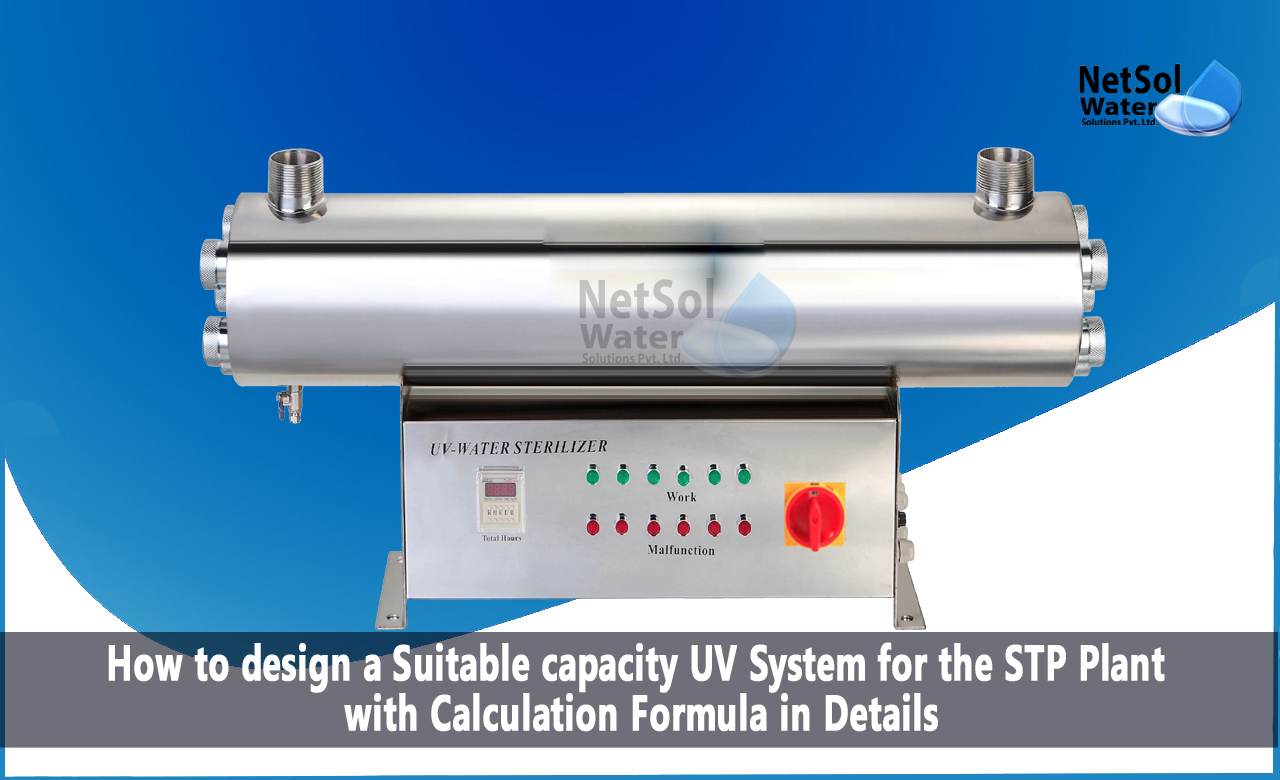Numerous UV systems are installed annually for sewage treatment plants. They offer protection against microbiological threats such viruses, bacteria, and cysts (including Giardia and Cryptosporidium). The majority of systems are installed in the basements and crawl spaces of houses and cottages on private water supplies; however, many are put in commercial and institutional buildings (restaurants, schools, pre-schools, etc.). Most are wisely implemented as a preventive step, but many are only installed as a result of having a poor water test.
A typical, simple UV disinfection system can be easily sized and installed. Typically, installation takes two hours or less. A step-by-step tutorial for designing a UV system is provided in this blog.
Design for suitable capacity UV System for the Sewage Treatment Plant:
Determine the maximum flow rate: The maximum flow rate is the flow rate that would be reached if all of the water outlets in the home or facility—including faucets, toilets, dishwashing sinks, showers, sprinkler systems, etc.—were fully opened simultaneously. The average, maximum, and minimum flow rates that the UV reactors will experience should be specified in the UV facility design criteria.
Determine the Water Quality: Water quality data should be collected from locations that are a representation of the potential UV facility location(s). The methods used to assess water quality for UV disinfection are comparable to those used for other water treatment technologies in terms of sampling time, sample counts, and data analysis. The data collection should include information on both the average water quality and any fluctuations in water quality brought on by storms, reservoir changes, seasonal changes, source water blends, and changes in upstream treatment. The unpredictability of the flow rate, the constancy of the source and treated water quality, and the possibility of achieving cost and energy savings by improving the design requirements should all be taken into consideration when determining the frequency of data collection.
Design? of the Lamp: Pressure and output are two features of ultraviolet disinfectant lamps. Depending on whether the lamp is on high or low, these two features are generated. There are three different kinds of bulbs used in UV disinfection systems.
The most energy-efficient lamps have low output and low pressure. These function best in lower flow situations that need to use less energy. Since they don't provide as much light as more potent lamps, more of them must be used, which takes up more space in the facility.
In systems with higher flow rates and a need for improved energy efficiency, Low Pressure/High Output lights are perfect. They have a larger footprint than MP lamps, but a lower footprint than LPLO lamps for treating the same amount of water.
Medium pressure bulbs are the best and most effective. If the structure can accommodate the lamps' power consumption, these lights can manage huge flow systems and have a smaller overall footprint than LPLO or LPHO lamps. They also have a lower operational lifespan than low pressure lamps.
Lamp location: It is possible to place the UV lights inside the reactor parallel or perpendicular to the effluent flow. Closed systems frequently set the lamps parallel to the flow because of the way they are built, although open channels can do either.
If parallel lamps were placed horizontally in the channel, the bed could be made shallower, but the area of disinfection would only be as large as the length of the lamps. These systems also take longer to replace lights since the entire configuration must be taken out of the channel.
Perpendicular lightings are positioned in a significantly deeper channel and lifted vertically. This increases the cross-sectional area of the disinfection section, and additional modules can be put next to and downstream of one another to hasten the effective reaction time of the disinfection. Additionally, because lamps can be raised up separately, replacing lights in this system takes far less time than replacing the complete module.
Amount of UV dosage: The UV dose used determines the degree of disinfection. Dose is a function of light intensity and time and represents the amount of UV that the water column is exposed to. The intensity increases with the lamp's power and the quality of the water. Similar to this, the longer the exposure duration (assuming a fixed flow rate) the larger and more hydraulically optimised the chamber. MilliJoules per square centimetre (mJ/cm2) are used to measure dosage. MicroWatt-seconds per square centimetre (W-sec/cm2) is another way to express this.
Installers typically select from one of three target dosage levels:
16 mJ/cm2: An increase in assurance for reliable water sources, such as municipal water. This dose reduces common infections like E. coli by 99.99 percent, or four logs.
30 mJ/cm2: the recommended dose for industrial applications using reliable water supplies.
40 mJ/cm2: The dose obligated to ensure the safety of water from potentially hazardous water supplies such as wells, lakes and rivers. Since viruses are more difficult to eradicate than most bacteria and cysts, a dose of 40 mJ/cm2 guarantees a 99.99 percent or 4-log reduction of viruses.
How To Calculate the UV Dose?
To determine the UV dose that will be required for disinfection, there is a formula that is frequently utilized:
UV Dose = UV Intensity (µW/cm2) x Exposure Time (seconds)
Do you need an advice or assistance on selecting the best water and waste water treatment unit? We have solutions for all your problems!
Let us now your problem, our experts will make sure that it goes away.
For an assistance or related query,
Call on +91-965-060-8473
Or write us at enquiry@netsolwater.com



